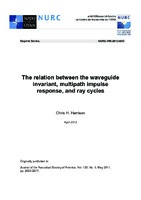| dc.contributor.author | Harrison, Chris H. | |
| dc.date.accessioned | 2018-10-11T14:09:43Z | |
| dc.date.available | 2018-10-11T14:09:43Z | |
| dc.date.issued | 2012/04 | |
| dc.identifier | 42937 | |
| dc.identifier.govdoc | NURC-PR-2012-005 | |
| dc.identifier.uri | http://hdl.handle.net/20.500.12489/668 | |
| dc.description.abstract | The waveguide invariant, b, that manifests itself as interference fringes or "striations" in a plot of frequency vs source-receiver separation, is usually thought of as a modal phenomenon. This paper shows that striations can be explained simply through the variation of the eigenray arrival times with range, in short, the variation of the multipath impulse response. It is possible to calculate b for a number of sound speed profiles analytically and to find what b depends on, why it switches from one value to another, how it depends on source-receiver depth, how it depends on variable bathymetry, and how smooth the sound speed profile needs to be for clear fringes. The analytical findings are confirmed by calculating striation patterns numerically starting from eigenray travel times in various stratified environments. Most importantly the approach throws some light on what can be deduced from b alone and the likelihood and utility of striations in reverberation. | |
| dc.format | 19 p. : ill. (digital, PDF file) | |
| dc.language | English | |
| dc.publisher | NURC | |
| dc.source | In: Journal of the Acoustical Society of America, Vol. 129, No. 5, May 2011, pp. 2683-2877. | |
| dc.subject | Acoustic propagation | |
| dc.subject | Waveguides | |
| dc.subject | Ray acoustics | |
| dc.subject | Ray tracing | |
| dc.title | The relation between the waveguide invariant, multipath impulse response, and ray cycles | |
| dc.type | Reprint (PR) | |
| dc.type | Papers and Articles | |
